What's that Buzz? Glue Repair for Resonator Boxes
By: Margaret Swain - 1/10/2017
|
Always begin your repair projects by wearing eye protection. Inexpensive safety glasses can be purchased at any hardware store. 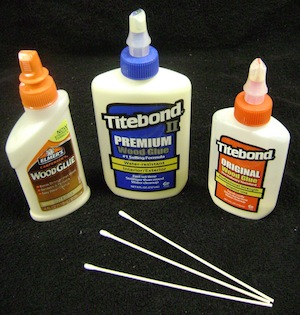 Buzzing sounds coming from xylophones and metallophones can have several causes ranging from the presence of debris inside the instrument, to a cracked bar, loose hardware, or disintegrating rubber pins or tubing. Once these potential causes have been eliminated, the most common source of buzzing, especially with bass instruments, is loose slats or loose bottom panels. The slats are the vertical pieces of wood that divide the resonator box into separate chambers. When instruments are new these are tightly secured to the walls of the resonator box, but over time they can become loose and vibrate when the tone bars are played. Similarly, the bottom panels of a resonator box can become loose, especially if bars have been stored or dropped inside the instrument. Start by purchasing a small container of wood glue. It will be easier to complete the repair if the bottle is not too large, so it will fit inside the smallest chamber. You may find it useful to have some cotton-tipped applicators on hand to aid in distributing the glue evenly. Buzzing sounds coming from xylophones and metallophones can have several causes ranging from the presence of debris inside the instrument, to a cracked bar, loose hardware, or disintegrating rubber pins or tubing. Once these potential causes have been eliminated, the most common source of buzzing, especially with bass instruments, is loose slats or loose bottom panels. The slats are the vertical pieces of wood that divide the resonator box into separate chambers. When instruments are new these are tightly secured to the walls of the resonator box, but over time they can become loose and vibrate when the tone bars are played. Similarly, the bottom panels of a resonator box can become loose, especially if bars have been stored or dropped inside the instrument. Start by purchasing a small container of wood glue. It will be easier to complete the repair if the bottle is not too large, so it will fit inside the smallest chamber. You may find it useful to have some cotton-tipped applicators on hand to aid in distributing the glue evenly. 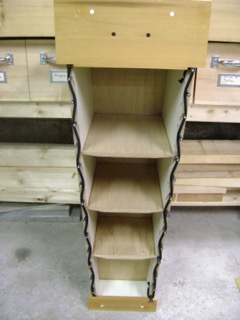
1. First remove the bars and thoroughly vacuum the resonator box. Set the resonator box up on one end. The slats will now look like shelves.
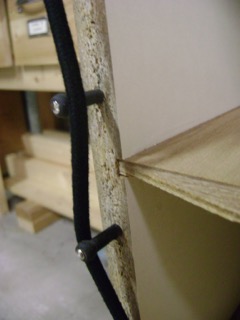
2. Pull the flexible tubing away from the resonator box so that it doesn’t get glue on it.
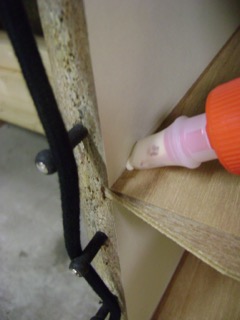
3. Run a bead of wood glue along all 3 junctures where the slat meets the resonator box wall and bottom panel. You are making a U-shape with your bead of glue. Do this for all the slats. (See photos below.) Keep the glue away from the flexible tubing and away from the nails and/or rubber pins. Wipe off any accidental glue drops with a damp cloth or sponge.
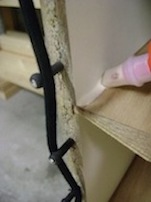  
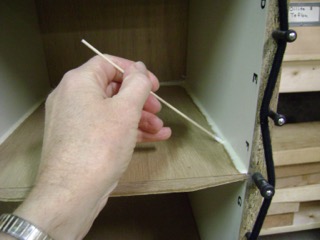
7. If needed, use a cotton tipped swab to distribute the glue evenly along the seams of the box. Don't worry if it looks a bit messy. The glue will dry clear.
Allow the glue to dry in this position for 48 hours. Reassemble the instrument and test for buzzing. If any buzzing remains, repeat steps 1-7, having set the resonator box up on its OTHER end, so you are gluing the back side of each slat. Occasionally it is the bottom panels of the resonator box, rather than the slats, that are loose. If so, glue them as above, but this time with the resonator box in its usual position, feet on the floor. © 2017
|
 |
| Back to Category List |
|
 Margaret Swain
Margaret Swain
I enjoy working to connect teachers to quality books and instruments for music and dance education. I hope you find my blog useful and interesting.
|
|
|
|
|
Orff Instrument Repair and Assembly (more)
Courses and Classes for Teachers (more)
Mallets (more)
Product Spotlights (more)
Orff Instruments (more)
|

|
|





 Buzzing sounds coming from xylophones and metallophones can have several causes ranging from the presence of debris inside the instrument, to a cracked bar, loose hardware, or disintegrating rubber pins or tubing. Once these potential causes have been eliminated, the most common source of buzzing, especially with bass instruments, is loose slats or loose bottom panels. The slats are the vertical pieces of wood that divide the resonator box into separate chambers. When instruments are new these are tightly secured to the walls of the resonator box, but over time they can become loose and vibrate when the tone bars are played. Similarly, the bottom panels of a resonator box can become loose, especially if bars have been stored or dropped inside the instrument. Start by purchasing a small container of wood glue. It will be easier to complete the repair if the bottle is not too large, so it will fit inside the smallest chamber. You may find it useful to have some cotton-tipped applicators on hand to aid in distributing the glue evenly.
Buzzing sounds coming from xylophones and metallophones can have several causes ranging from the presence of debris inside the instrument, to a cracked bar, loose hardware, or disintegrating rubber pins or tubing. Once these potential causes have been eliminated, the most common source of buzzing, especially with bass instruments, is loose slats or loose bottom panels. The slats are the vertical pieces of wood that divide the resonator box into separate chambers. When instruments are new these are tightly secured to the walls of the resonator box, but over time they can become loose and vibrate when the tone bars are played. Similarly, the bottom panels of a resonator box can become loose, especially if bars have been stored or dropped inside the instrument. Start by purchasing a small container of wood glue. It will be easier to complete the repair if the bottle is not too large, so it will fit inside the smallest chamber. You may find it useful to have some cotton-tipped applicators on hand to aid in distributing the glue evenly. 







